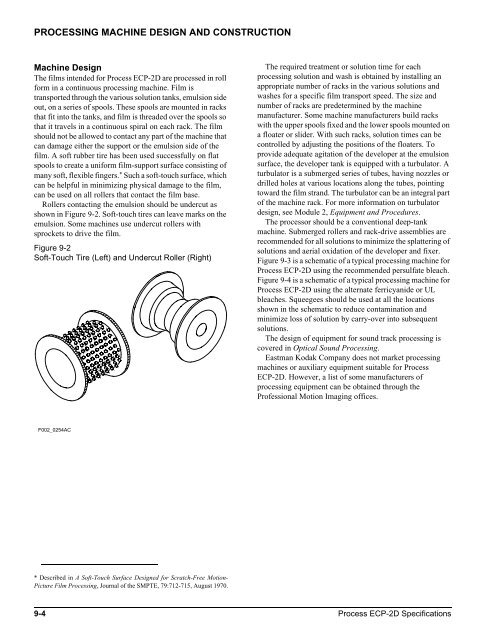films and process sequence ... - Kodak
films and process sequence ... - Kodak
films and process sequence ... - Kodak
Create successful ePaper yourself
Turn your PDF publications into a flip-book with our unique Google optimized e-Paper software.
PROCESSING MACHINE DESIGN AND CONSTRUCTION<br />
Machine Design<br />
The <strong>films</strong> intended for Process ECP-2D are <strong>process</strong>ed in roll<br />
form in a continuous <strong>process</strong>ing machine. Film is<br />
transported through the various solution tanks, emulsion side<br />
out, on a series of spools. These spools are mounted in racks<br />
that fit into the tanks, <strong>and</strong> film is threaded over the spools so<br />
that it travels in a continuous spiral on each rack. The film<br />
should not be allowed to contact any part of the machine that<br />
can damage either the support or the emulsion side of the<br />
film. A soft rubber tire has been used successfully on flat<br />
spools to create a uniform film-support surface consisting of<br />
many soft, flexible fingers. * Such a soft-touch surface, which<br />
can be helpful in minimizing physical damage to the film,<br />
can be used on all rollers that contact the film base.<br />
Rollers contacting the emulsion should be undercut as<br />
shown in Figure 9-2. Soft-touch tires can leave marks on the<br />
emulsion. Some machines use undercut rollers with<br />
sprockets to drive the film.<br />
Figure 9-2<br />
Soft-Touch Tire (Left) <strong>and</strong> Undercut Roller (Right)<br />
F002_0254AC<br />
* Described in A Soft-Touch Surface Designed for Scratch-Free Motion-<br />
Picture Film Processing, Journal of the SMPTE, 79:712-715, August 1970.<br />
The required treatment or solution time for each<br />
<strong>process</strong>ing solution <strong>and</strong> wash is obtained by installing an<br />
appropriate number of racks in the various solutions <strong>and</strong><br />
washes for a specific film transport speed. The size <strong>and</strong><br />
number of racks are predetermined by the machine<br />
manufacturer. Some machine manufacturers build racks<br />
with the upper spools fixed <strong>and</strong> the lower spools mounted on<br />
a floater or slider. With such racks, solution times can be<br />
controlled by adjusting the positions of the floaters. To<br />
provide adequate agitation of the developer at the emulsion<br />
surface, the developer tank is equipped with a turbulator. A<br />
turbulator is a submerged series of tubes, having nozzles or<br />
drilled holes at various locations along the tubes, pointing<br />
toward the film str<strong>and</strong>. The turbulator can be an integral part<br />
of the machine rack. For more information on turbulator<br />
design, see Module 2, Equipment <strong>and</strong> Procedures.<br />
The <strong>process</strong>or should be a conventional deep-tank<br />
machine. Submerged rollers <strong>and</strong> rack-drive assemblies are<br />
recommended for all solutions to minimize the splattering of<br />
solutions <strong>and</strong> aerial oxidation of the developer <strong>and</strong> fixer.<br />
Figure 9-3 is a schematic of a typical <strong>process</strong>ing machine for<br />
Process ECP-2D using the recommended persulfate bleach.<br />
Figure 9-4 is a schematic of a typical <strong>process</strong>ing machine for<br />
Process ECP-2D using the alternate ferricyanide or UL<br />
bleaches. Squeegees should be used at all the locations<br />
shown in the schematic to reduce contamination <strong>and</strong><br />
minimize loss of solution by carry-over into subsequent<br />
solutions.<br />
The design of equipment for sound track <strong>process</strong>ing is<br />
covered in Optical Sound Processing.<br />
Eastman <strong>Kodak</strong> Company does not market <strong>process</strong>ing<br />
machines or auxiliary equipment suitable for Process<br />
ECP-2D. However, a list of some manufacturers of<br />
<strong>process</strong>ing equipment can be obtained through the<br />
Professional Motion Imaging offices.<br />
9-4 Process ECP-2D Specifications

















